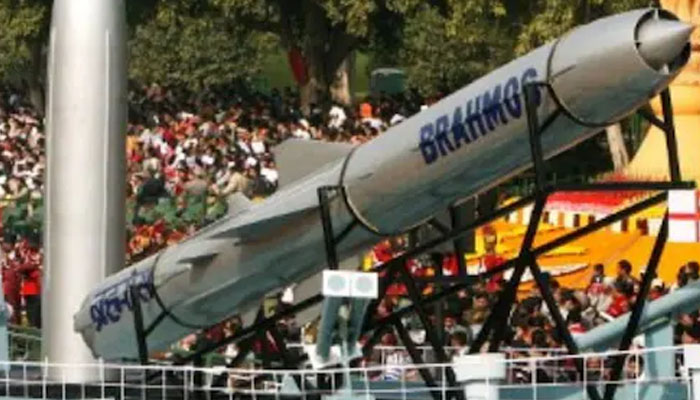India sacks air force officers for ‘firing’ missile into Pakistan
The unarmed BrahMos surface-to-surface supersonic missile was accidently launched from a secret military base in northern India in early March
NEW DELHI: The Indian Air Force on Tuesday sacked three officers for the accidental firing of a cruise missile into nuclear-armed rival Pakistan following a months-long investigation by New Delhi.
The unarmed BrahMos surface-to-surface supersonic missile was accidently launched from a secret military base in northern India in early March before the projectile landed roughly 125 kilometers inside Pakistani territory without causing any damage to life or property.
A statement by the air force said that a probe into the incident had found three of its officers guilty of violating standard operating procedures that led to the mishap. “These three officers have primarily been held responsible for the incident. Their services have been terminated by the Central Govt with immediate effect,” the statement said.
Islamabad had said that a “supersonic flying object” cruising at 40,000 feet from India had violated its airspace and hit an uninhabited civilian area on March 9. New Delhi had immediately acknowledged the mistake, which Islamabad said endangered civil air planes and lodged a diplomatic protest. India had termed the incident “deeply regrettable” and promised an investigation at the highest level. Pakistan had demanded a joint probe into the misfire and questioned New Delhi’s nuclear and missile safety protocols.
But in a rare instance, both the nuclear-armed nations unusually downplayed the incident despite a history of deep mistrust and hostility. BrahMos is one of India’s frontline nuclear-armed projectiles and is believed to be among the fastest cruise missiles in the world. It can be launched from land, sea and air.The cruise missiles -- travelling at three times the speed of sound -- are jointly developed by India and Russia, and named after India’s river Brahmaputra and Russia’s Moskva River, with ranges varying from 300 to 700 kilometers.
-
 Prince Harry Urges His Pals Are ‘not Leaky,’ He Is Not ‘Mr Mischief’
Prince Harry Urges His Pals Are ‘not Leaky,’ He Is Not ‘Mr Mischief’ -
 What Prince William And Kate Think Of Brooklyn's Attack On Victoria And David Beckham?
What Prince William And Kate Think Of Brooklyn's Attack On Victoria And David Beckham? -
 Meghan Trainor Reveals Why Surrogacy Was The 'safest' Choice
Meghan Trainor Reveals Why Surrogacy Was The 'safest' Choice -
 Victoria Beckham Supports Youngest Son In First Move Since Brooklyn's Rebellion
Victoria Beckham Supports Youngest Son In First Move Since Brooklyn's Rebellion -
 'Percy Jackson' Star Feels Relieved After Season Two Finale
'Percy Jackson' Star Feels Relieved After Season Two Finale -
 Jelly Roll Reveals How Weight Loss Changed Him As A Dad: 'Whole Different Human'
Jelly Roll Reveals How Weight Loss Changed Him As A Dad: 'Whole Different Human' -
 Prince Harry Gets Emotional During Trial: Here's Why
Prince Harry Gets Emotional During Trial: Here's Why -
 Queen Camilla Supports Charity's Work On Cancer With Latest Visit
Queen Camilla Supports Charity's Work On Cancer With Latest Visit -
 Dove Cameron Opens Up About Her Latest Gig Alongside Avan Jogia
Dove Cameron Opens Up About Her Latest Gig Alongside Avan Jogia -
 Petition Against Blake Lively PGA Letter Gains Traction After Texts With Taylor Swift Revealed
Petition Against Blake Lively PGA Letter Gains Traction After Texts With Taylor Swift Revealed -
 Netflix Revises Warner Bros. Deal To $83 Billion: All-cash Offer
Netflix Revises Warner Bros. Deal To $83 Billion: All-cash Offer -
 Prince Harry Mentions Ex-girlfriend Chelsy Davy In UK Court
Prince Harry Mentions Ex-girlfriend Chelsy Davy In UK Court -
 David, Victoria Beckham 'quietly' Consulting Advisers After Brooklyn Remarks: 'Weighing Every Move'
David, Victoria Beckham 'quietly' Consulting Advisers After Brooklyn Remarks: 'Weighing Every Move' -
 Meta's New AI Team Delivered First Key Models
Meta's New AI Team Delivered First Key Models -
 Prince Harry Defends Friends In London Court
Prince Harry Defends Friends In London Court -
 AI May Replace Researchers Before Engineers Or Sales
AI May Replace Researchers Before Engineers Or Sales




